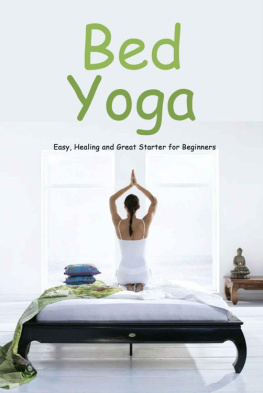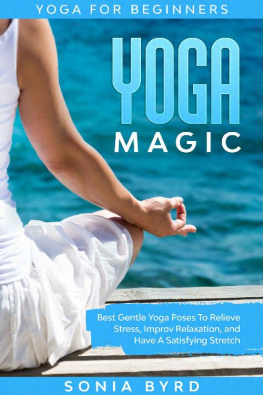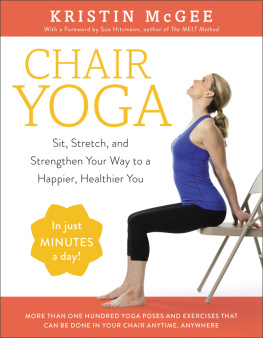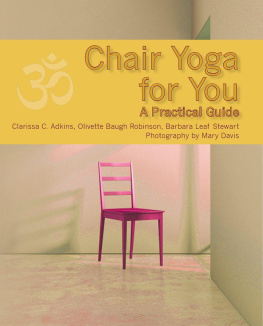Chair Yoga
FOR BEGINNERS
The Complete Guide to Easy Yoga Sequences and
Poses Suitable for Every Age That You Can Do
Sitting at Home in 10 Minutes to Improve
Strength, Flexibility, and Calmness.
SOPHIA MORALES
Copyright Sophia Morales 2021 - All rights reserved.
The content contained within this book may not be reproduced, duplicated or transmitted without direct written permission from the author or the publisher.
Under no circumstances will any blame or legal responsibility be held against the publisher, or author, for any damages, reparation, or monetary loss due to the information contained within this book. Either directly or indirectly.
Legal Notice:
This book is copyright protected. This book is only for personal use. You cannot amend, distribute, sell, use, quote or paraphrase any part, or the content within this book, without the consent of the author or publisher.
Disclaimer Notice:
By reading this document, the reader agrees that under no circumstances is the author responsible for any losses, direct or indirect, which are incurred as a result of the use of information contained within this document, including, but not limited to, errors, omissions, or inaccuracies.
TABLE OF CONTENTS
Introduction
W e should all make it a habit to practice yoga because it can relieve the aches we get from being seated for long periods. For this reason, it is essential to include movement in your daily life to boost your health and well-being. Chair yoga is a workout regimen that incorporates movements that help stretch and strengthen your body, while also getting your head in the right place.
Do you spend your days on the couch? Do you get out of bed to sit in a car, in a bus, on a subway, or at your workplace before going home to sit on the sofa or in bed and watch TV or surf the web?
Does your description fit? Though it may be an exaggeration, our occupations are all different. A lot of individuals live very stationary lives, engaging in things like eating, driving, flying, typing, reading, and a whole host of other pursuits. Regardless of how much we try to avoid them, chairs are unavoidable, and our feet all need a break eventually. The balance has shifted, though. Because of their heavy labor, early ancestors spent much of their time standing and working. We, humans, were made to be active. Our modern-day conveniences, like televisions and laptops, have created the opportunity for us to spend many of our days doing nothing but relaxing.
Finally, the inactivity of sitting in a chair all day is gaining some notice. Recent research has concluded that long-term sitting may contribute to many health issues. For all people across the world, the World Health Organization's fourth-leading risk factor for mortality is physical inactivity.
Long periods of sitting can lead to a wide range of conditions, including diabetes, high cholesterol, high blood pressure, poor posture, and muscle imbalances. During our time here, our organs aren't having to work at their maximum capacity; our lungs aren't filling with air, either. Not only that, but we end up with sciatica, compression of our discs, a loss of abdominal strength, and an increased rate of aging. To sit for a full day with excellent posture and attentiveness is unusual.
Those in need of special assistance, the elderly, or those who are required to travel regularly are frequently compelled to sit for extended periods because of extenuating circumstances. While it's unfortunate, there is a remedy that can assist everyone who feels trapped in a chair, moving better, having more energy, awareness, and joy!
A good chair yoga exercise to use to stretch out the muscles in your back, legs, and neck is sitting and then raising your arms above your head with your hands clasped together. Because it can be practiced on a chair and requires no special skills, chair yoga is the most accessible type of yoga. Anyone who is limited in their range of motion or can't move about much should find this practice advantageous. Chair yoga will enable you to cultivate a heightened level of mindfulness during work, before a meal, when traveling, or while sitting at a doctor's office. It is possible to perform it in any chair, whether or not it is stationary or mobile.
Chair Yoga offers simple workouts for greater health with step-by-step directions and images. Every chapter targets a different aspect of the body's muscular system. If you look, you may easily find a few minutes to exercise every day. You will see amazing advantages in your physical and emotional health.
Getting Started
T o perform chair yoga, you need a chair, your breath, your desire, and your body! You'll notice you're getting better sleep, feeling better, eating better, and being more focused, energetic, and strong if you can work these exercises into your regular sitting routine. The key to doing well in a posture or movement is to maintain your breath close and use it as a guide. I will explain this later in Chapter 1. No matter the workout you perform, if you link your thoughts and breath, you can do it in any sequence.
If you've had a hard day, you may need to treat yourself with a little self-care, such as a massage or getting up and moving around. The best aspect is that all the exercises can be applied to any sort of seat, and you are sure to find something in the table of contents that interests you.
Regardless of where you decide to start reading, I recommend reading the opening chapter, Breathe In, first. Once you've learned to control your breathing, you can perform yoga moves anywhere.
This book was particularly designed for those who spend most of their time sitting down. Even if you have trouble finding time to move around during the day, you can always take a chair yoga break. It can be done anywhere, such as on a plane, bus, doctor's office waiting room, or even at your desk chair or sofa at home. What you're wearing, the sort of chair you're sitting in, and your surroundings aren't important. Yoga as an art requires a practitioner to focus their whole attention on the present now and tap into their life energy to keep their body limber, strong, and healthy. Alright, let's begin!
Chapter 1: Breathe-In
Y oga would be only calisthenics and stretching without the attention on the breath. Yoga is wonderful and unique because of the breath. As a simple practice, breathing exercises are very easy to adopt and do regularly. The very air we breathe affects our happiness and health.
Breath is the first point for yoga. Pranayama, or breath control, is a type of breathing exercise; we use it to benefit greatly. Prana, which is Sanskrit for breath or vital energy, can be defined as On subtler levels, prana signifies the life force energy. Ayama translates to control. Pranayama, then, is breath control. You will find a variety of breathing methods you may employ while practicing in this chapter. This includes the following: kapalbhati, kumbhaka, sitali, bhastrika, viloma, and nostril breathing.
Breathing is one of our most important methods for altering our mental state. Are you ever aware of holding your breath when you're nervous or stressed? Maybe you are always rushed, and as a result, you take shallow, fast breaths all day long. The right technique for breathing may help us maintain our mental health, as well as our physical health and overall well-being.














